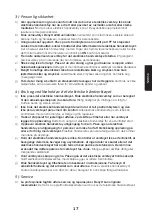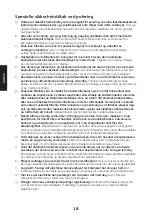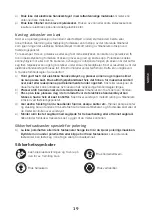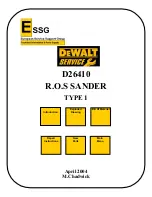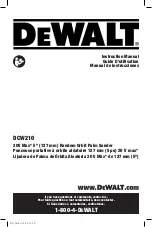
EN
G
LI
S
H
4
3) Personal safety
a)
Stay alert and attentive to the project at hand and use common sense whenever
operating a power tool. Never use power tools if you are tired or under the influence
of drugs, alcohol or medication.
One moment of inattention while using a power tool may
result in serious personal injury.
b)
Use personal protective equipment. Always wear eye protection.
Using protective
clothing such as dust masks, non-slip safety shoes, helmets and ear defenders reduces
the risk of injury.
c)
Prevent unintentional starting. Make sure that the power switch is set to OFF before
plugging the power tool into a wall socket, fitting the battery or picking up/carrying
the power tool.
Carrying a power tool with your finger on the power switch/trigger or
connecting the power tool to a wall socket when the power switch is set to ON is inviting
an accident.
d)
Remove any adjusting key or wrench before switching the power tool on.
A service tool
left on a rotating part of the power tool may result in personal injury.
e)
Do not overreach. Keep proper footing and balance at all times.
This enables better
control of the power tool in unexpected situations.
f)
Wear suitable clothing. Do not wear loose-fitting clothing or jewellery. Keep hair,
clothes and gloves away from moving parts.
Loose-fitting clothes, jewellery or long hair
could become caught in moving parts.
g)
If devices are provided for the connection of dust extraction and collection facilities,
ensure that these are connected and used properly.
Use of dust collection equipment can
reduce dust related hazards.
4) Power tool use and care
a)
Do not force the power tool. Use the correct power tool for your application.
The correct power tool will do the job better and safer if used at the rate for which it was designed.
b)
Do not use the power tool if the power switch does not switch the tool on and off properly.
Any power tool that cannot be controlled by the power switch is dangerous and must be repaired.
c)
Disconnect the plug from the power source and/or the battery pack from the power
tool before making any adjustments, changing accessories or storing the power tool.
These precautions reduce the risk of the power tool starting unexpectedly.
d)
Store power tools that are not being used out of children’s reach. Do not allow people
who are unfamiliar with the tool or these instructions to operate the tool.
Power tools
are dangerous in the hands of untrained users.
e)
Properly maintain your power tools. Check for misalignment or binding of moving
parts, broken parts or anything else which might affect the operation of the power tool.
If something is damaged, have the power tool repaired before use.
Many accidents are
caused by poorly maintained power tools.
f)
Keep cutting tools sharp and clean.
Properly maintained cutting tools with sharp cutting
edges are less likely to bind and are easier to control.
g)
Use the power tool and any accessories in accordance with these instructions
and taking into account the working conditions and the work to be performed.
Using the power tool for a purpose other than that for which it is intended could result in
a dangerous situation.
5) Service
a)
Repairs and service should only be performed by qualified tradesmen, and only with
original spare parts.
This guarantees that the safety of the power tool is maintained.
Summary of Contents for 18-3578
Page 2: ...2...

















